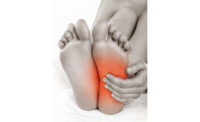Almost 150 years ago doctors warned of the occupational health risks of prolonged standing at work. In the 1870s and 1880s, doctors in Paris, London and New York began to report large numbers of “shop girls” suffering foot ailments caused by prolonged standing.
In today’s economy, with the emphasis on service sector jobs, research points out almost half of all workers worldwide spend more than three-quarters of their workday on their feet. At-risk jobs are many, including “old economy” machine operators, printing press workers and assembly line workers; and service workers such as checkout operators, health care workers, bank staff, casino workers, reception staff, pharmacy technicians and hotel desk clerks.
Health effects
Employees earning their living by spending all or most of their days on their feet are at greater risk of health problems including varicose veins, poor circulation and swelling of the feet and legs, foot problems, joint damage, heart and circulatory problems, and pregnancy difficulties. Other standing-related health problems include bunions and corns, heel problems, Achilles tendonitis, flat feet, low back pain, arthritis in knees and hips, stiffness in neck and shoulders, and high blood pressure.
“Basically, the body does not like to have the same posture or load placed on it continuously,” says the director of environmental and occupational hygiene at the University of Cincinnati, in a previously published article.
Hard concrete floors are about the worst possible surface to stand on for most or all of a work day. Two hours of standing on the job is not associated with problems, but a longer period is likely to have detrimental effects, according to a Swiss researcher. Older workers, common in today’s economy, and those employed in heavy manual jobs frequently develop knee and joint pain as they get older, and may become progressively less able to cope with constant standing, according to studies.
Overall, the most commonly reported symptoms appear to be discomfort, fatigue and swelling of the legs. Back pain associated with work is about twice as common in employees who stand compared to those who usually work sitting, according to studies.
What to do
Constant sitting is not the answer -- not the safe alternative to constant standing. Prolonged sitting carries its own health risks, studies show. The first step is simple awareness. For hundreds, even thousands of years, standing on the job has been the norm and thus often taken for granted. The health consequences are often ignored or simply not known, especially regarding longer-term issues such as high blood pressure, heart and circulatory problems, and problems in pregnancy and birth defects.
Every employee is different. Some will complain about standing; others remain quiet. Safety and health professionals should first read up on the literature regarding prolonged on-the-job standing, identify at-risk jobs in the workplace, and educate both management and employees. Having facts in hand is important for selling solutions. Options include more rest breaks, alternating standing and walking with sitting, and work station redesign -- making work surfaces height-adjustable, using a foot-rail or footrest to enable workers to shift weight from one leg to the other, and using elbow supports for precision work.
Anti-fatigue matting can be used wherever workers have to stand for long periods. Two types of comfort matting are: floor mats and insoles. Anti-fatigue floor mats should be easy to clean and have sloped edges so they don’t become a trip hazard. Floor mats comes in various thicknesses and materials, such as a durable natural rubber mat or a sponge mat with a vinyl-nitrile outer surface to withstand wear and tear, and an inner layer of blown vinyl-nitrile sponge for comfort. Other materials include urethane, injection- molded PVC, and PVC sponges. Some mats have various surface patterns – pebbled, diamond-plate or bubble domes. Lightweight mats can easily be cut to size on-site and rolled up and stored for maintenance. Non-conductive matting insulates and protects workers from shocks generated by high-voltage equipment. Mat life expectancy depends on foot traffic, exposure to oils, caustic chemicals or fluids, temperature extremes, and cleaning and maintenance schedules.
Insoles are inserted into work shoes or boots and the shock-absorbing material is in direct contact with the feet. They are available in numerous sizes, are machine washable, and are hygienic, with anti-fungal, anti-bacterial, anti-perspiration and odor-reducing properties. Insoles can also be non-conductive for shock protection and puncture-resistant.
Other options include rubber overshoes that fit over most types of footwear, including steel-toe safety footwear, and socks for industrial athletes that offer comfort and protection from heat and cold.
If you’re not already using these types of solutions, let the anti-fatigue battle begin. Many of your workers stand and deliver all day long, they face potentially serious health effects, and they shouldn’t stand for it.









